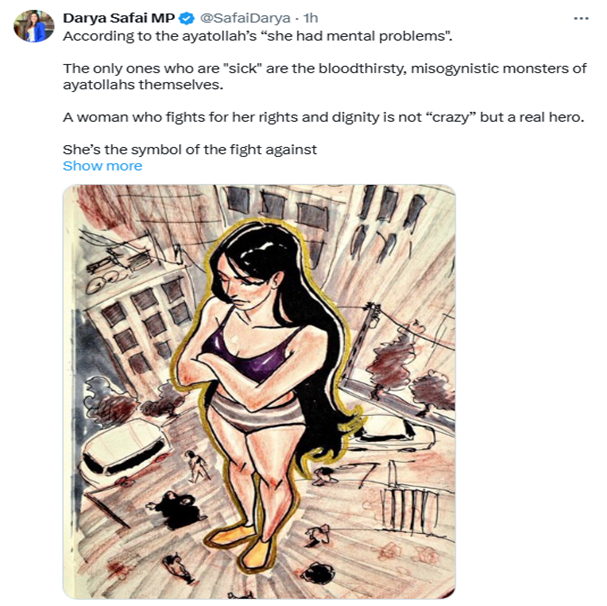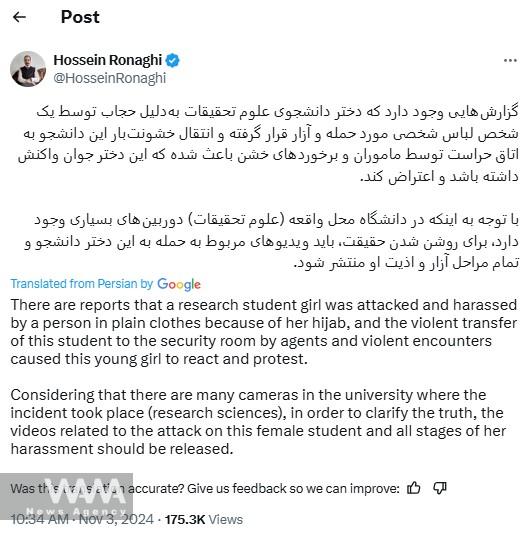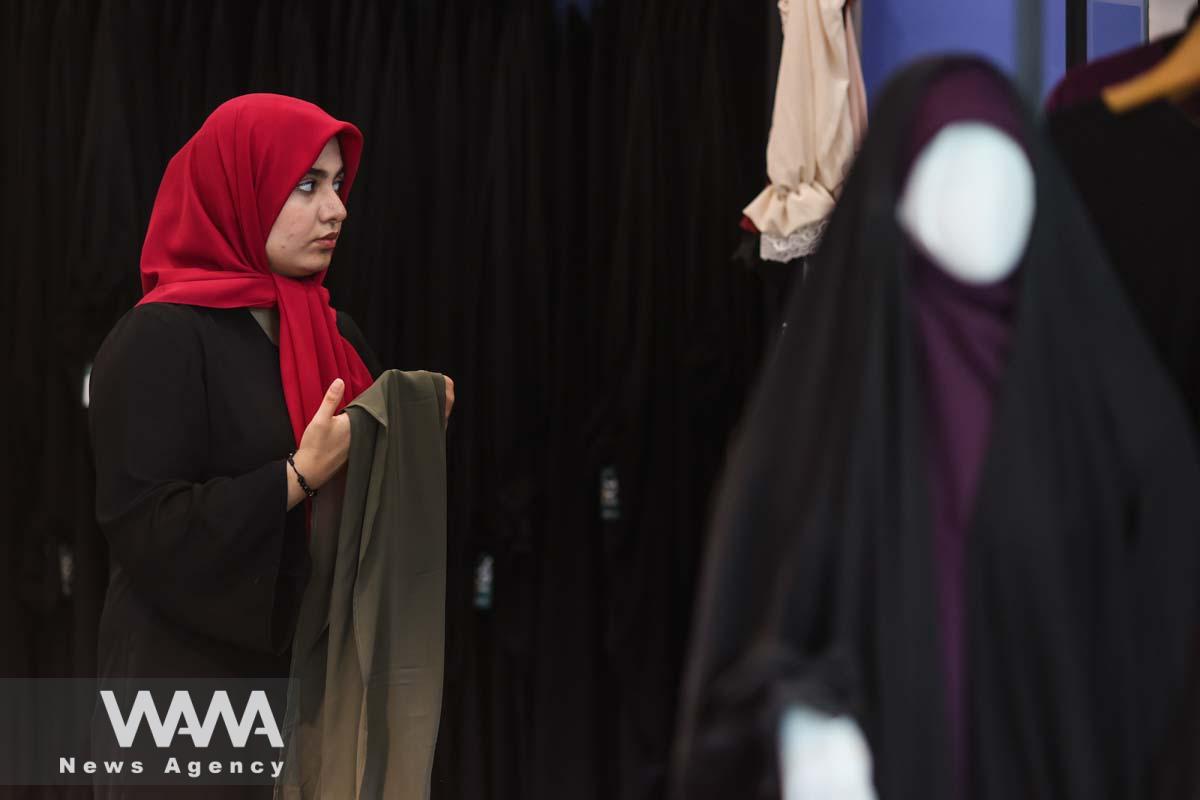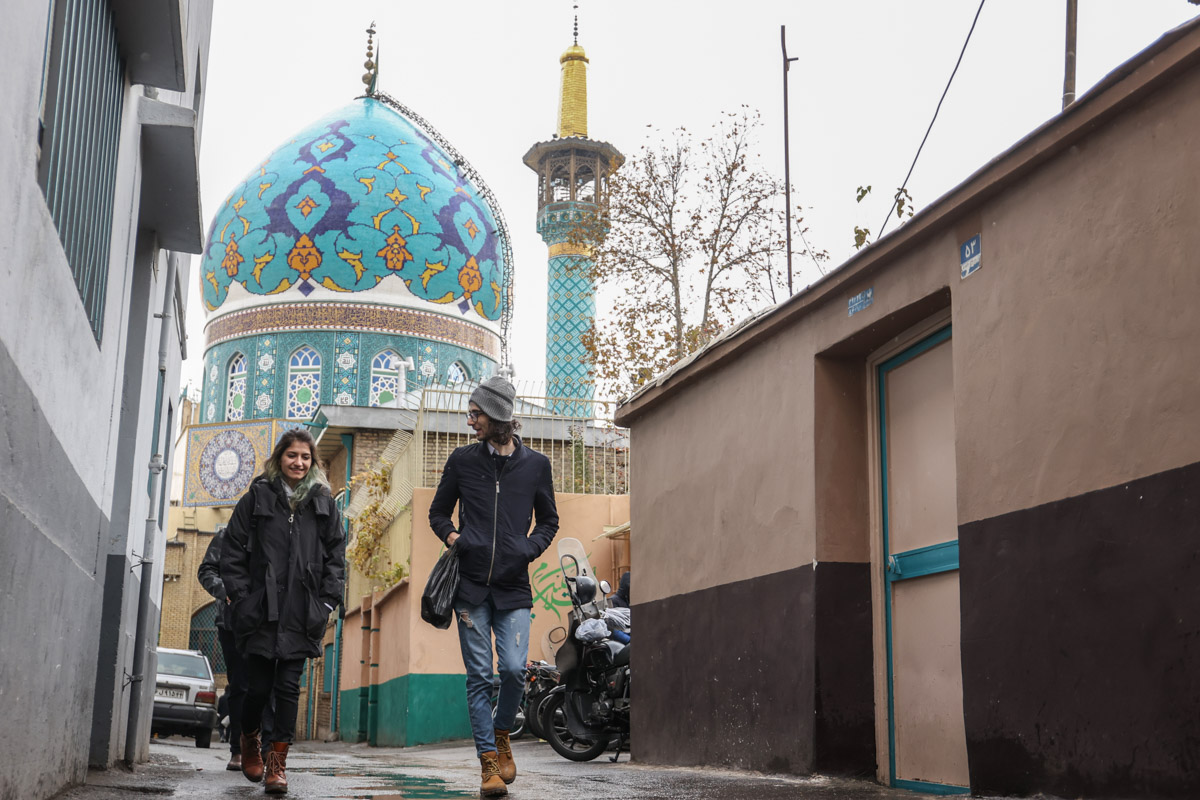Iran’s Opponents Exploit Women for Political Gains
WANA (Nov 05) – A few days ago at the Islamic Azad University of Science and Research in Tehran, a strange and reaction-provoking incident occurred: a female student unexpectedly stripped naked in the university courtyard. This event quickly became a hot topic among various groups and on social media.
Opponents of the Islamic Republic of Iran, activists supporting social movements, and advocates for women’s rights interpreted this act as a sign of the revival of the “Women, Life, Freedom” movement, which was sparked by street protests following the death of Mahsa Amini. Some even presented the woman as a new symbol of heroism and emerging resistance against restrictions.

The Iranian MP of Belgian Tweet reaction, Social media/ WANA News Agency
This incident has been accompanied by many controversies and rumours. One of these rumours concerned the alleged beating of the female student and her suffering injuries, but this was refuted by the videos that were released.
In none of the videos do we see any confrontation between university officials or security personnel and the woman who fully removed her hijab in public. So far, no individual or group has claimed that there was a harsh response from the authorities toward the female student.
According to statements from the husband and classmates of the female student, Ms A.D., who is studying French literature at the University of Science and Research, she has been struggling with mental health issues.

“There was no attack; Ms A.D., my classmate in French literature, is not mentally stable. She has numerous disciplinary cases at the university and has caused significant physical and psychological disturbances for us and other students,” this is provided by a user on X named Taraneh regarding this woman.
Multiple sources provide evidence that contrary to statements by supporters of the “Women, Life, Freedom” movement and according to official announcements from credible sources, the individual who carried out this act suffers from severe mental health issues. Her mental condition was so severe that, following her initial arrest, she was first handed over to the police and then quickly hospitalized in a psychiatric facility.

Amir Mahjoob, the Public Relations Director of Islamic Azad University, also tweeted: “Following an indecent act by one of the students at the University of Science and Research, the university’s security intervened and handed her over to the police station… Contrary to online rumours and fantasies, there was no physical altercation between the security personnel and this student, and after multiple warnings from the security officers, the offending student was handed over to the law enforcement officers… At the police station, and after examination by medical teams, it was determined that she was under severe mental distress and had psychological disorders. It should be noted that, in addition to being separated from her former husband, she is also the mother of two children…”
In the sensitive context of the region, and following Israel’s recent attack on Iran, which revealed Iranians’ lack of fear or anxiety and the absence of psychological pressure resulting from this attack, Iran’s opponents believe that by reigniting the hijab and anti-hijab issue, they might be able to inflame the domestic atmosphere in Iran and shift the focus of Iranian forces from national defense to potentially suppressing these types of internal conflicts and disturbances.

BBC’s Oversight in Providing Evidence on Nika Shakarami’s Death
WANA (June 13) – Last month, BBC World aired a controversial documentary about the death of Nika Shakarami, claiming to present new evidence that Iranian security forces killed her for participating in the 2022 protests. The BBC stated that they possessed documents verified by various experts. Since airing the documentary, the BBC has yet […]
The opposition to the Islamic Republic, both inside and outside Iran, has widely circulated the footage of this woman undressing on social media, showing little concern for the emotional, psychological, and familial damage this may cause her or her family.
Their view of this incident and of the student is purely instrumental, aimed at opposing Iran’s rulers. What seems to matter to no one is protecting the dignity and honour of this Iranian woman, who, in fact, suffers from mental health issues and is in need of help to navigate this critical situation.
The political and security system in Iran, after decades, is fully aware of the agendas that certain movements pursue by exploiting such incidents. The Iranian government has learned how to neutralize or render these types of conspiracies ineffective.
It was anticipated that the incident of the female student undressing in the university courtyard would turn into a situation similar to that of Mahsa Amini, but the lifespan of this news did not exceed 24 hours, and the public showed no inclination to engage in the opponents’ narrative against the Islamic Republic.

Hijab in Iran: A Continuing Challenge
WANA (August 05) – The use of clothing in any society is shaped by its specific standards and patterns, reflecting its unique culture and religious beliefs. These standards and frameworks evolve due to the influence of various cultures, changing societal beliefs, and shifts in governance and dynasties, and Iran is no exception to these changes. […]
One reason why the Iranian public did not align with the opponents of the Islamic Republic in this matter may be their awareness of the double standards these opponents have regarding “human rights.”
The people of Iran believe that the situation of Palestinian women, who are currently victims of Israeli violence, deserves attention. Meanwhile, most of the Islamic Republic’s opponents either strongly support Israel or show no concern about the killing of women and children in Palestine.
In the midst of the 2022 events (following Mahsa Amini’s death), a woman named Niloufar Fooladi publicly stripped in Amsterdam, the Netherlands. At first, anti-Iran groups cheered for her, highlighting her in their media. Later, however, when it became clear how this issue backfired, reinforcing the arguments of Iran’s supporters who claim that it’s not just about a headscarf and that there are suspicious agendas behind the scenes, some opponents began spinning the narrative a few months later that she was, in fact, a regime agent.
In most cases, these kinds of actions by opponents of the government in Iran are eventually rejected by the public or fail to gain widespread support. A major issue for Western supporters inside Iran is their lack of understanding of Iranian culture, which is one of the main reasons why many of their regime-change strategies are ineffective.
Most Iranian women do not relate to the campaigns launched under the banner of “supporting women.” The fact that some people in the country oppose or object to the hijab is an issue that needs to be examined closely. It is essential to assess how much of this opposition stems from cultural divides and how much serves as a symbol of protest against economic and political issues.

Which is implemented , the political Hijab or the religious Hijab?
WANA (Mar 09) – A few months have passed since the recent riots in Iran, and now it is possible to have a better analysis and a clearer picture of the situation. In the first days of the street riots, the concern about the law to abolish the mandatory hijab was more prominent than […]












